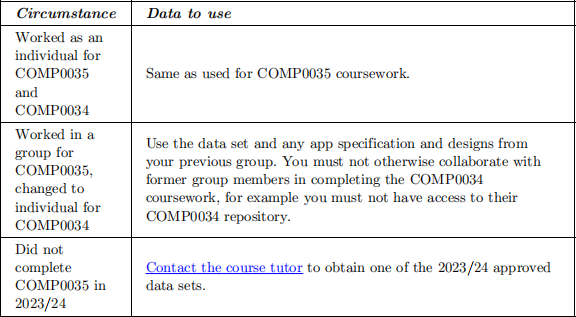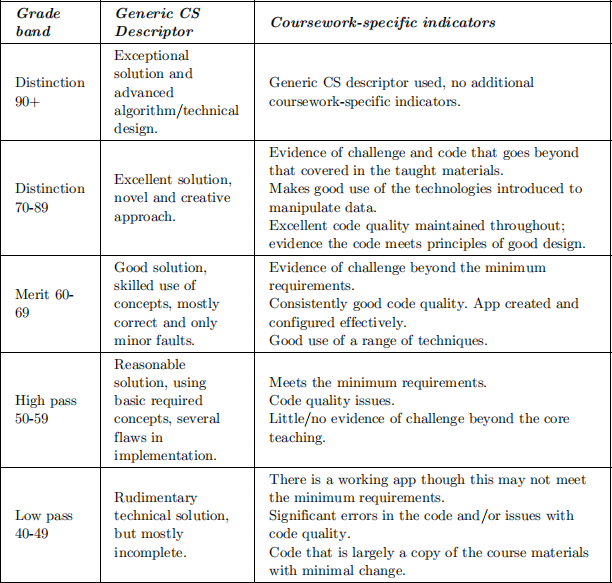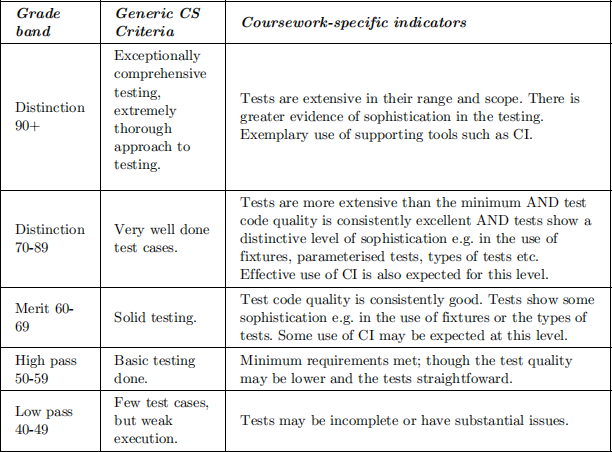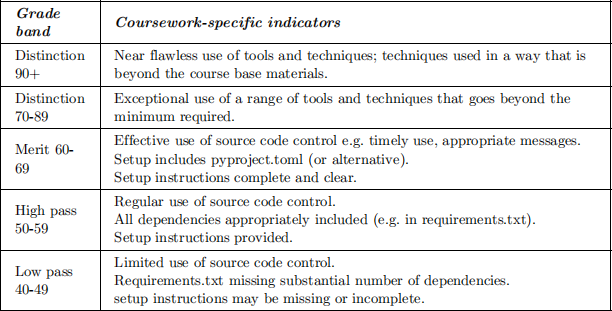COMP0034 2023/24 Coursework 1 specification
Hello, dear friend, you can consult us at any time if you have any questions, add WeChat: daixieit
COMP0034 2023/24 Coursework 1 specification (Individual)
Version: 1.0 Released 05/01/24
Contents
1. Introduction
2. Getting started
3. Technologies that must be used
4. Coursework content
5. Submission
6. Marking
7. Appendices
1. Adding challenge
2. Unresolved bugs and code issues
3. Referencing
4. Support and guidance
5. Changes to coursework submission dates
6. SoRA and EC
7. Late submission penalties
8. Data sets
1. Introduction
This document specifies coursework 1 which is worth 50% of the assessment marks available for the module.
In this coursework you will develop and test a REST API application using Python Flask and your allocated data set from COMP0035.
Marks are allocated for:
2. Test code
2. Getting started
1. Create a GitHub repository using GitHub classroom:
1. Login to GitHub.com.
2. Click on the GitHub classroom link for individuals.
3. Accept the assignment.
4. If prompted, accept to join the comp0035-ucl organisation.
2. Add a copy of your data set from COMP0035 to your repository.
You must only use the data sets as approved for COMP0035.
Which data set to use depends on your circumstances:

3. Technologies that must be used
1. GitHub for source code control.
Use GitHub, with repositories created in GitHub classroom to allow tutors and PGTAs to gain access. If you can’t use GitHub for some reason please contact the course tutor to
agree alternative source code control.
2. Python coding environment.
Use a Python coding environment such as Visual Studio Code, PyCharm Professional or similar. Jupyter notebooks is not an accepted submission format for the coursework.
3. Flask python library.
You must use python Flask to create the core REST API app. You may use additional Python libraries to support your work.
4. Use .pdf or .md format for written content.
All written evidence must be combined into a single file and submitted either as PDF or
markdown. Name this comp0034-coursework1.pdf or comp0034-coursework1.md as appropriate.
4. Coursework content
The minimum requirements for each section are listed below.
See appendices for suggestions to increase the challenge evidenced in your work.
Application code
Write code to create a REST API using Flask that returns data from your data set. The app code must be submitted with an appropriate file and folder structure for a Flask app. Jupyter notebooks are not accepted.
The minimum required:
· A Flask app that can be run in development mode from the command line. · One GET route.
· One POST route.
· One PUT or DELETE route.
· Interacts with the data set data. The minimum is to read from the .csv/.xslx files. · Returns JSON format data.
There is no written evidence expected for this section. However, if there is something you wish
to explain in relation to the code then please add a section called ‘Application code’ to comp0034-coursework1.pdf/md.
Test code
Write code tests for the REST API using pytest and the Flask test client. Code must be submitted as Python files in an appropriate file and folder structure for tests. Jupyter
notebooks are not accepted.
Add evidence of the tests being run to the comp0034-coursework1.pdf/md document in a section named ‘Testing’ .
The minimum required:
· Two tests for each route in your application.
· Evidence that the tests have been run (e.g. screenshot).
Use of tools and techniques
Provide evidence of the use of relevant software engineering tools and techniques.
The minimum required:
· Source code control:
![]() You must use GitHub for source code control unless otherwise agreed in advance with the course tutor.
You must use GitHub for source code control unless otherwise agreed in advance with the course tutor.
![]() Add the URL of your GitHub repository in a section called ‘Tools and techniques’ in
Add the URL of your GitHub repository in a section called ‘Tools and techniques’ in
comp0034-coursework1.pdf/md.
![]() Demonstrate use of source code control throughout the coursework. Evidenced by commit history in GitHub.
Demonstrate use of source code control throughout the coursework. Evidenced by commit history in GitHub.
![]() Appropriate use of .gitignore. Evidence by presence of .gitignore file in GitHub.
Appropriate use of .gitignore. Evidence by presence of .gitignore file in GitHub.
· Provide instructions in README.md which the marker (or any other developer) can use to configure and run your app.
· Dependency management: Provide a requirements.txt file (or appropriate alternative).
Any additional evidence for this section should be added tocomp0034-coursework1.pdf/md.
References
Add a section called ‘References’ to comp0034-coursework1.pdf/md.
References should include:
· Acknowledgement of the use of AI
· Attribution for the data set
· Code references
· Books, papers, websites etc. (if used)
See the Appendix - Referencing for details on how to reference each of the above.
5. Submission
Submit your work on Moodle as a single .zip in the assignment submission. Refer to Moodle for the deadline date and time.
Moodle is used as the submission date/time and to authenticate students. GitHub is not an accepted submission system.
The .zip should expand to the correct folder structure with all required files. Ensure that all
files are included in the zip, files that are only provided as URLs will be excluded from marking consideration (since they may be modified after the coursework is submitted). Do not include
virtual environment, venv files please.
The submission must include:
![]() Application code
Application code
![]() Test code
Test code
![]() comp0034-coursework1.pdf or comp0034-coursework1.md. If using markdown make sure any linked files are also included in the submission.
comp0034-coursework1.pdf or comp0034-coursework1.md. If using markdown make sure any linked files are also included in the submission.
6. Marking
Mark allocation and calculation
An average module is expected to take around 150 learning hours.
Each coursework should take 20-25 hours.
An indication of the effort given the marking weighting is shown below.
|
Component |
Percentage |
Expected hours |
|
App code |
55% |
11 |
|
Test code |
35% |
7 |
|
Tools and techniques |
10% |
2 |
Grading criteria
The ‘UCL Computer Science: Marking Criteria and Grade Descriptors’ will be used to assess
the coursework (using only the criteria that are relevant to this coursework). In addition to the standard descriptors, further guidance is given for this coursework in the table below.
As there can be a wide range of solutions it isn’t possible to cover everything you might do to achieve a given level. The following should be used as guidance.
Higher mark bands assume that the criteria from lower bands have been fully achieved.
App code
As a guide, marking considers aspects such as:
![]() are the minimum requirements met?
are the minimum requirements met?
![]() range of skills/sophistication/challenge evidenced in the resulting application code
range of skills/sophistication/challenge evidenced in the resulting application code
![]() code quality: Python standards, structure and configuration of the application, use of
code quality: Python standards, structure and configuration of the application, use of
functions and/or classes, DRY and other design principles

Test code
As a guide, marking considers aspects such as:
![]() did you meet the minimum requirements of this section?
did you meet the minimum requirements of this section?
![]() evidence of challenge and sophistication in the test code.
evidence of challenge and sophistication in the test code.
![]() the quality and structure of the test code. This includes code quality, test naming and structure, documentation, appropriate use of assertions, use of fixtures etc.
the quality and structure of the test code. This includes code quality, test naming and structure, documentation, appropriate use of assertions, use of fixtures etc.

Tools and techniques
As a guide, marking considers aspects such as:
![]() Did you meet the minimum requirements of this section?
Did you meet the minimum requirements of this section?
![]() Has source code control been used regularly and appropriately?
Has source code control been used regularly and appropriately?
![]() Are the dependencies managed using an appropriate technique? Are all the dependencies included?
Are the dependencies managed using an appropriate technique? Are all the dependencies included?
![]() Are set up instructions provided? Was the app able to be run after the set-up instructions were followed?
Are set up instructions provided? Was the app able to be run after the set-up instructions were followed?
These are not covered by the generic CS grading criteria.

1. Adding challenge
2. Unresolved bugs and code issues
3. Referencing
4. Support and guidance
5. Changes to coursework submission dates
6. SoRA and EC
7. Late submission penalties
8. Data sets
1. Adding challenge
The following are suggestions of things you might do to increase the challenge of your solution. This is not an exhaustive list and other suggestions may be given in the course materials.
Application code
· More challenging routes (PUT and DELETE).
· Interacts with a SQLite database using Flask-SQLAlchemy rather than direct to .csv/.xlsx files.
· Effective error handling (HTTP errors, data interactions etc.).
Test code
· Test for edge cases
· Test for error conditions
· Tests with multiple values
· More effective/extensive use of fixtures
· Report on coverage and demonstrate that you understand the report
Tools and techniques
· Continuous integration (tests, linting)
· Linting
If you use other tools/techniques please provide screenshots, PDF, or other formats that can be downloaded and included in your zip (these must be able to be opened using freely available
tools). URL links to external sites are not accepted for marking purposes.
2. Unresolved bugs and code issues
There may be problems with your code that you were not able to address in the timescales of the project. This is not unusual either for the coursework or in real life.
If this occurs, add the following to the comp0034-coursework1. (pdf/md) in an ‘Application code’ section, or ‘Testing’ section if it relates to the test code:
· what the problem is or how it is affecting your app
· where in the code the issue is
· what steps you took to try and address the issue
3. Referencing
Acknowledgement of the use of AI
If you did not use AI then clearly state this. Otherwise, you must include the following details:
· Name and version of the generative AI system used; e.g. ChatGPT-3.5
· Publisher (company that made the AI system); e.g. OpenAI
· URL of the AI system.
· Brief description (single sentence) of context in which the tool was used.
· Statement of how the AI influenced your code.
This is based on UCL student guidance on the use of AI. |
Reference your dataset
Include any details to acknowledge your dataset (attribution) to comply with any license condition required for your data set (given in the data set link in COMP0035 Moodle).
Book, journal, web article etc. references
It is unlikely to you will have any but if you do then include them.
For book, journal, and web article references, follow the referencing style you use in your own department (e.g. Harvard, APA). Different departments in UCL use different styles.
Code references
How to cite code
UCL has no single method for referencing code. For the purposes of this coursework use the following.
· Give the author, URL and the date of retrieval. If you adapted the code, indicate “Adapted from” or “Based on” .
· Include citations within your code using code comments close to the affected code.
An example:
def play_sound(button_text):
# Adapted from code from 'remdog' on the Plotly Community Forum at
# https://community.plotly.com/t/linking-scatter-plot-elements-to-audio-
files/11908/6
# Accessed 01/02/21
...some code here...
When to cite code
You must cite external sources; including where you copy and then adapt the code. External sources include:
· user forums e.g. stack overflow
· open source repositories e.g. GitHub repos where an explicit open source license is stated · communities associated with a library e.g. plotly forum
· course teaching materials
· official library documentation and tutorials of the python libraries and frameworks
It is not appropriate to copy from other students on the course, past or present.
You do not need to cite:
· code from the COMP0035 course teaching materials.
· boilerplate code from the official library documentation of the required python libraries and frameworks that are expected to be used in the coursework e.g. flask, flask-
sqlalchemy.
4. Support and guidance
The assessments start in week 1 (coursework 1) and week 5 (coursework 2) of the course. You are expected to make progress each week.
1. Moodle activities (online): There are weekly activities and checkpoints in Moodle to guide your progress.
2. Weekly lab/tutorial sessions (in person): Module staff will be available to provide support and guidance in weekly lab/tutorial sessions. Use these sessions to complete
activities and then work on your coursework.
3. Tutor office hours (online): The tutor will be available during a weekly module office hour (see Moodle).
4. Moodle Q&A (online): You can ask questions at any time in the Moodle Q&A forum where anyone in the course is able to reply. When posting questions about your code,
please post the URL to your repository. This enables the tutor and PGTAs to see your code which is usually essential for solving technical problems! Other students won’t be able to access your repository from this URL so long as your repository is private and is within the ucl-comp0035 organisation.
5. Changes to the coursework submission date
Coursework submission dates are set centrally in Computer Science and not by the course tutor.
These have been planned carefully to fit with the teaching schedule.
Requests to change these for all students must be made to thecourse tutor who will then
forward the request to the relevant authority in the computer science department. Requests must be supported with appropriate evidence of the need for change.
6. SoRA and EC
If you have an approved extension resulting from a SoRA or EC, these will be carefully checked by the teaching and learning team before marks are entered in portico.
However, the deadlines in Moodle may not be modified for individuals, so it may appear on
Moodle that your submission is late even though you have an approved extension to cover the period.
7. Late submission penalties
Late submission rules apply to all assessments.
Any penalties for late submission are applied by the computer science teaching and learning team when marks are entered in portico.
The mark you see in the Moodle gradebook may not be your final mark as it is the mark before moderation or any penalty has been applied.
8. Data sets
Only use the ethics approved data sets.
The data sets allocated to students on this course have been approved by the Computer Science Ethics Committee and signed by the Head of Department for use in this course. These data
sources comply with GDPR and UCL ethics and data protection policies. You must not use any other data set for the coursework.
The approved data sets do not require data protection registration and since you will not be working with participants in your project there is no requirement to complete any further
training relating to data protection and GDPR.
2024-02-02